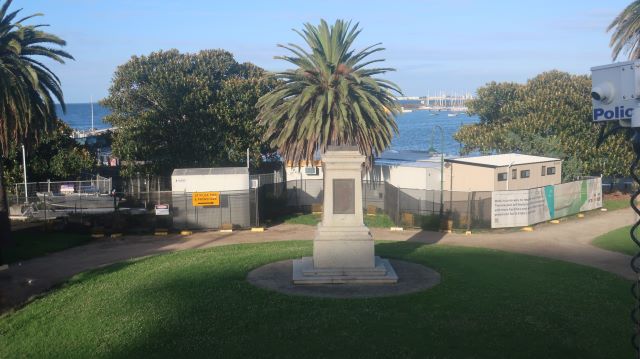
Commemorations in St Kilda
The bronze statue of James Cook in St Kilda’s Catani Gardens was severed at the ankles in the early hours of Thursday 25 January. The words “the colony must fail” were sprayed across the plinth in red paint.
The statue, ignored for 364 days of the year, comes into intense focus each year in the lead up to January 26 – Australia Day/Invasion Day/Survival Day – a day which is more contested year on year.
The statue is awkwardly situated behind the Royal Melbourne Yacht Squadron near Jacka Boulevard. Heather Arnold, in her excellent Carlo Catani blog1, explains that this was not the original location for the statue gifted by Andrew Stenhouse to the St Kilda Shore Committee of which he was a member. The Committee reclaimed and beautified the St Kilda foreshore. At that time, Stenhouse lived opposite in Beaconsfield Parade. He was as closely associated with Broken Hill as he was with St Kilda. He accumulated his considerable wealth from importing and supplying timber to the mining industry. The statue was a second casting of the original in Whitby, Yorkshire.
When first unveiled by Governor Sir Arthur Stanley in December 1914, the statue occupied a more central position on the reclaimed foreshore which, because of the prominence of the sculpture, came to be known as Captain Cook lawns. The gardens were only later named for their designer, Carlo Catani. It appears that the statue was moved in 1988, the Bicentenary year, to make way for the present pavilion/rotunda in Catani Gardens. This suggests that a pavilion was thought to be sufficiently important and valuable to warrant the re-location of the Cook statue.
Was there a furore? Perhaps members of the St Kilda Historical Society would know.
The speeches marking the occasion of the unveiling of the statue of ‘heroic size’ suggest that the Governor, and those present, well understood Cook’s power as a symbol for the development of Australia2.
The statue was unveiled against the background of the First World War. Then, as now, Cook’s name was invoked in support of a national cause: “Nothing would have given Captain Cook greater satisfaction than to have seen with his mind’s eye the youth of Australia in their great argosy which had recently sailed from these shores to Egypt.”2
This morning, just metres away from the contentious statue, a large and solemn crowd gathered in the dark at Alfred Square for the fifth We-Akon Dilinja mourning ceremony presented by Boonwurrung Land and Sea Council and supported by the City of Port Phillip.
Parbinata Dr Carolyn Briggs welcomed us to the traditional lands of the Yalukit Weelam clan, part of the Kulin nations. She reiterated the promises that were expected in exchange for the welcome extended to visitors: to respect the land and the waters, and the children. To do no harm. To celebrate life.
Zoe Daniel, the member for Goldstein, acknowledged that it had been a difficult year for reconciliation with the defeat of the referendum. She reminded the gathering that people across the south eastern suburbs of Melbourne had strongly voted ‘Yes’, and this is the foundation on which to move forward. “The path has changed, but the goal remains the same”, she said.
Nina Taylor, the member for Albert Park, retraced the steps that have been taken to lay the foundation for Treaty in Victoria – a treaty with self determination at its heart.
Jason Briggs, CEO of the Boonwurrung Land & Sea Council, was emphatic that the way forward was together, as modelled in this ceremony, and that divisive actions such as the vandalising of the statue were not supported or condoned. His theme was building bridges, wide bridges, bridges with many places to access.
Shauntai Sherree Abdul-Rahman gave full voice to “Long Time Living Here” a Boonwurrung song written by Deborarh Cheetham AO, Parbinata Carolyn Briggs, Jarra Steel & Aunty Fay Stewart Muir.
After the smoking ceremony, it was time for catching up with friends with a renewed sense of possibility that we can build a richer shared future together.
After the ceremony, I went to O’Donnell Gardens to spend time with a different kind of public artwork.
St Kilda has always been an important gathering place for Aboriginal and Torres Strait Islander people from all over Australia. When their gathering place in Cleve Gardens was demolished in preparation for the Grand Prix in 1996, the meeting place shifted to O’Donnell Gardens next to Luna Park.
Three bronze milk crates sit in the lee of a stone wall.
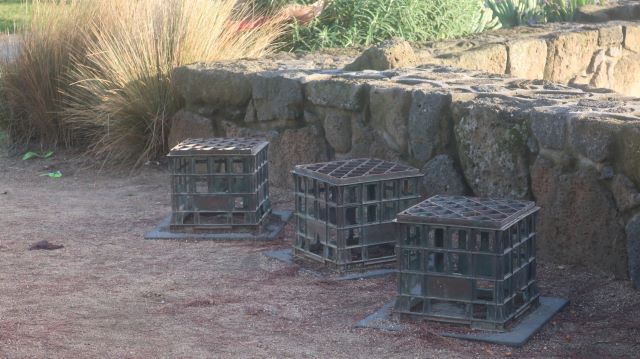
Artist Julie Shiels recalls how the work came into being: “The idea for this work came from a conversation with Aunty Alma in 2002 when we were both sitting on plastic milk crates in St Kilda’s O’Donnell Gardens. I remarked what good seats they were but she said she often had to hunt around to find one. I suggested that we could turn them into bronze and put them in permanently.
After that, every time I saw Aunty Alma she would say, ‘You got to do that, babe. Put it in bronze.’ I was already hunting for money when she died in April 2003, so I felt even more compelled to make at least one seat for her. She was a queen of the park.
When another well-known Elder, ‘Boom Boom’ Forbes died the next year, everyone said Aunty Alma would get lonely just being honoured with one crate so found enough money to make three crates. The third is for the living.”3
Shiels challenged the ‘heroic’ statue and brought it right down to earth, as well as memorialising people who had been traditionally ‘out of scope’ for public acknowledgement and recognition.
Read more
1 Heather Arnold Carlo Catani
2 CAPTAIN COOK MEMORIAL. (1914, December 8). The Argus (Melbourne, Vic. : 1848 – 1957), p. 6. Retrieved January 26, 2024, from http://nla.gov.au/nla.news-article10821020
3 Julie Shiels Aunty Alma’s seat
Watch the livestream of We-Akon Dilinja from the City of Port Phillip website
2 Comments
-
Judy
Thank you Janet. Such interesting and important territory traversed with hope and a model for a constructive way forward

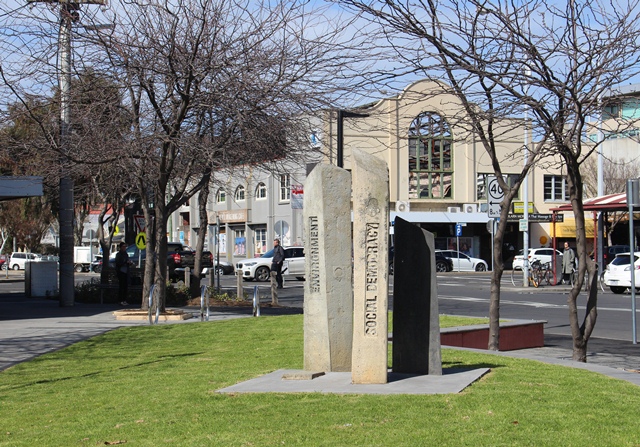
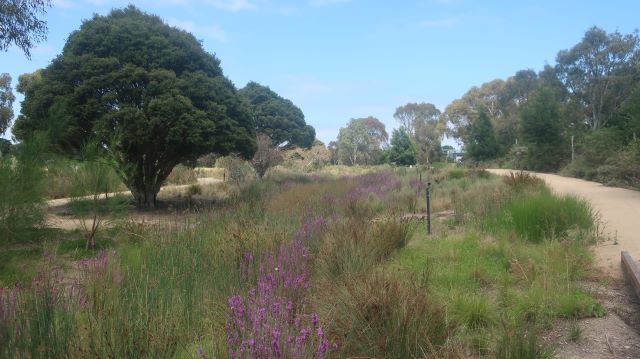
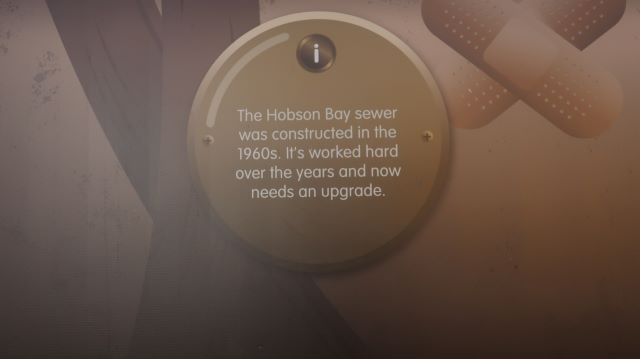
Linda N
What an interesting account Janet. Thx for sharing.